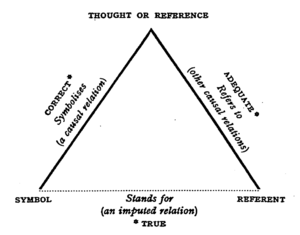Reference facts for kids
A reference is like a pointer or a link from one thing to another. It helps us connect ideas or objects. When something "refers to" something else, it means it points to it or names it. The thing doing the pointing is called the name, and the thing being pointed to is called the referent.
For example, the word "dog" refers to the animal dog. Here, "dog" is the name, and the actual furry animal is the referent. References can be thoughts, sounds, pictures, or even feelings. They help us understand how different things are connected in the world. Sometimes, references are hidden on purpose, like in secret codes.
References are used in many parts of our lives and in different subjects. The way we use the word "reference" can change slightly depending on the situation.
Contents
What Does "Reference" Mean?
The word reference comes from an old French word, référer, which means "to carry back." This word itself came from the Latin word referre, meaning "to bear" or "to carry." Many words we use today come from this same root, like refer, referee, and referendum.
When we say "refer to," it often means "to connect to" or "to link to." But it can also mean "to look up information," like when you use a reference work (like an encyclopedia) or ask for a job reference (someone who can tell about your skills).
References in Language

In language, a reference is how words or phrases connect to the things they name. For example, the word "John" refers to a specific person named John. The word "it" refers to something that was already mentioned. The thing a word refers to is called its referent.
Sometimes, two different words can refer to the exact same thing. Imagine "Hesperus" and "Phosphorus." These were ancient Greek names. "Hesperus" was the name for the evening star, and "Phosphorus" was the name for the morning star. But both names actually refer to the planet Venus! Even though they refer to the same planet, knowing that "Hesperus is Phosphorus" was still new and interesting information for people back then. This shows that the "meaning" of a word isn't always the same as what it "refers to."
Some parts of speech, like pronouns (words like "he," "she," "it"), are mainly used for referring. For example, in "The man washed himself," the word "himself" refers back to "the man."
References in Computers
In computer science, references are special types of data. They act like addresses that point to other pieces of information stored in a computer's memory. Imagine a treasure map where the "X" on the map is a reference, and the treasure chest is the actual data.
These references are used to build many different kinds of data structures. For example, they help create linked lists, which are like chains of information where each link points to the next one. Most programming languages use some form of reference.
The idea of references is also important in database theory. This is called referential integrity. It means that if you have information in one part of a database that refers to information in another part, those links must always be correct and unbroken.
References in Libraries and Information
When we talk about books, articles, or websites, we use references to find them. These references can be electronic or digital.
- For books, there's the ISBN. It's a unique number for each book.
- For articles in journals, there's the Digital Object Identifier (DOI). This is like a permanent online address for the article.
- For information on the Internet, we use a Uniform Resource Identifier (URI), which is basically a web address.
These identifiers make it easy to find specific pieces of information quickly.
References in Schoolwork
In school and academic work, a reference is a piece of information that tells you where an author got their facts or ideas. You usually find these in footnotes or a bibliography at the end of a book, essay, or report. A typical reference includes the author's name, the title of their work, and the year it was published.
The main reason for using references is to let readers check the sources of information. This helps them see if the information is correct or to learn more about the topic.
References are super important for citations. If you use someone else's words or ideas without giving them credit, it's called plagiarism. Plagiarism is like stealing someone's intellectual property. It can lead to serious problems, including legal proceedings.
A "reference" section usually lists only the works that were directly quoted or used in the main text. A "bibliography" section might include other works that the author read for background, even if they weren't directly cited.
Scholars study how references work because they are key to good communication and cooperation between different people. They also help prevent misunderstandings.
References in Law
In patent law, a reference is a document that shows what was already known when someone invented something new. This helps decide if an invention is truly new or if it's too similar to something that already exists. Examples of references include other patents, magazine articles, or even online materials that are publicly available.
References in Art
In art, a reference is something an artist uses as a starting point or inspiration for their work. This could be:
- An existing piece of art.
- A photograph.
- A real object or person the artist observes.
- The artist's own memory.
Another example is in music, where artists might use samples (small parts) from other songs to create a new piece of music.
See also
 In Spanish: Referencia para niños
In Spanish: Referencia para niños
- Antecedent (grammar)
- Exemplification
- Generic antecedent
- Hyperlink
- Indexicality
- ISO 690
- Recommendation letter
- Signified and signifier

